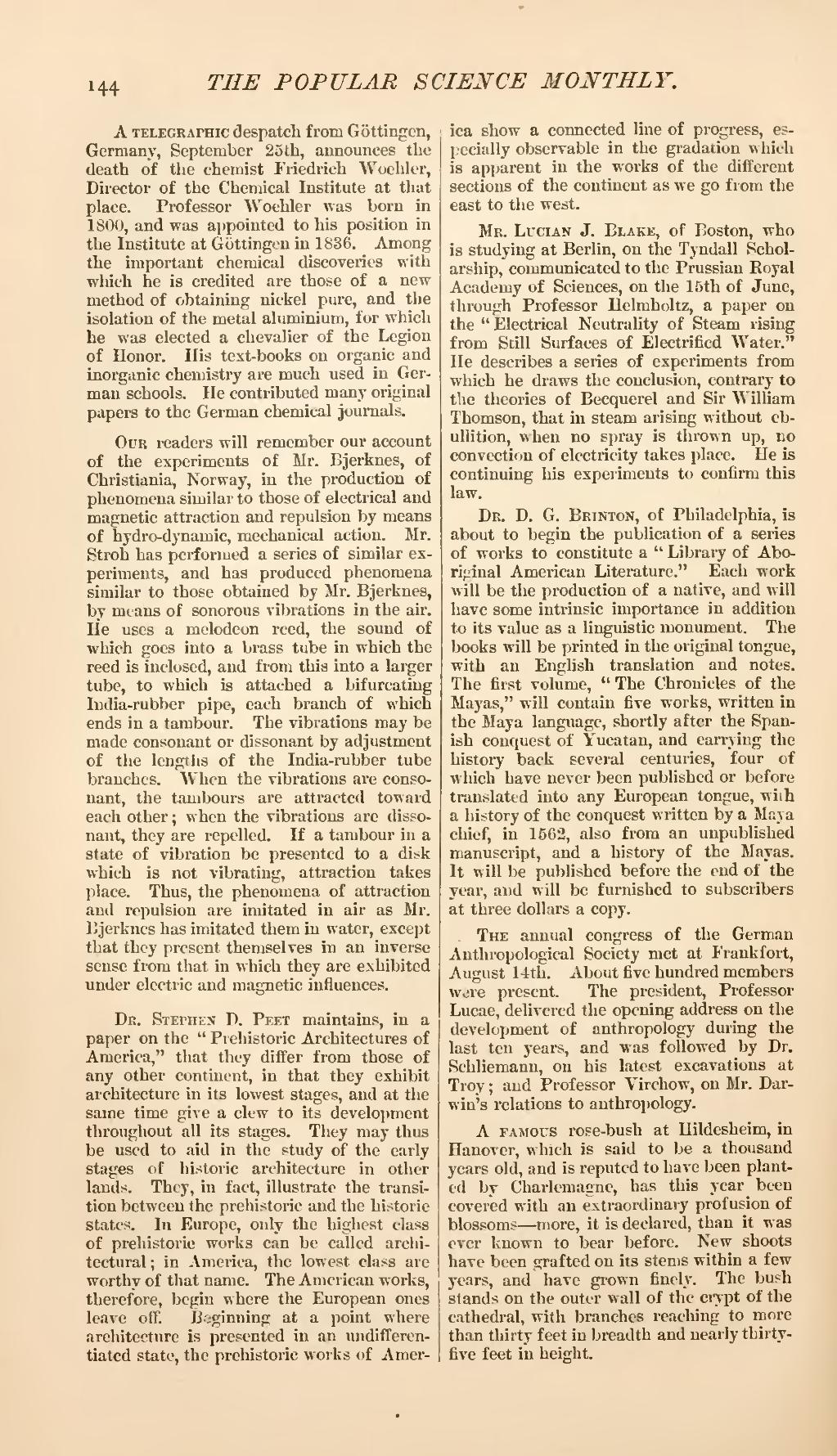A telegraphic despatch from Göttingen, Germany, September 25th, announces the death of the chemist Friedrich Woehler, Director of the Chemical Institute at that place. Professor Woehler was born in 1 800, and was appointed to his position in the Institute at Göttingen in 1836. Among the important chemical discoveries with which he is credited are those of a new method of obtaining nickel pure, and the isolation of the metal aluminium, for which he was elected a chevalier of the Legion of Honor. His text-books on organic and inorganic chemistry are much used in German schools. He contributed many original papers to the German chemical journals.
Our readers will remember our account of the experiments of Mr. Bjerknes, of Christiania, Norway, in the production of phenomena similar to those of electrical and magnetic attraction and repulsion by means of hydro-dynamic, mechanical action. Mr. Stroh has performed a series of similar experiments, and has produced phenomena similar to those obtained by Mr. Bjerknes, by means of sonorous vibrations in the air. He uses a melodeon reed, the sound of which goes into a brass tube in which the reed is inclosed, and from this into a larger tube, to which is attached a bifurcating India-rubber pipe, each branch of which ends in a tambour. The vibrations may be made consonant or dissonant by adjustment of the lengths of the India-rubber tube branches. When the vibrations are consonant, the tambours are attracted toward each other; when the vibrations are dissonant, they are repelled. If a tambour in a state of vibration be presented to a disk which is not vibrating, attraction takes place. Thus, the phenomena of attraction and repulsion are imitated in air as Mr. Bjerknes has imitated them in water, except that they present themselves in an inverse sense from that in which they are exhibited under electric and magnetic influences.
Dr. Stephen D. Peet maintains, in a paper on the "Prehistoric Architectures of America," that they differ from those of any other continent, in that they exhibit architecture in its lowest stages, and at the same time give a clew to its development throughout all its stages. They may thus be used to aid in the study of the early stages of historic architecture in other lands. They, in fact, illustrate the transition between the prehistoric and the historic states. In Europe, only the highest class of prehistoric works can be called architectural; in America, the lowest class are worthy of that name. The American works, therefore, begin where the European ones leave off. Beginning at a point where architecture is presented in an undifferentiated state, the prehistoric works of America show a connected line of progress, especially observable in the gradation which is apparent in the works of the different sections of the continent as we go from the east to the west.
Mr. Luctan J. Blake, of Boston, who is studying at Berlin, on the Tyndall Scholarship, communicated to the Prussian Royal Academy of Sciences, on the 15th of June, through Professor Helmholtz, a paper on the "Electrical Neutrality of Steam rising from Still Surfaces of Electrified Water." He describes a series of experiments from which he draws the conclusion, contrary to the theories of Becquerel and Sir William Thomson, that in steam arising without ebullition, when no spray is thrown up, no convection of electricity takes place. He is continuing his experiments to confirm this law.
Dr. D. G. Brinton, of Philadelphia, is about to begin the publication of a series of works to constitute a "Library of Aboriginal American Literature." Each work will be the production of a native, and will have some intrinsic importance in addition to its value as a linguistic monument. The books will be printed in the original tongue, with an English translation and notes. The first volume, "The Chronicles of the Mayas," will contain five works, written in the Maya language, shortly after the Spanish conquest of Yucatan, and carrying the history back several centuries, four of which have never been published or before translated into any European tongue, with a history of the conquest written by a Maya chief, in 1562, also from an unpublished manuscript, and a history of the Mayas. It will be published before the end of the year, and will be furnished to subscribers at three dollars a copy.
The annual congress of the German Anthropological Society met at Frankfort, August 14th. About five hundred members were present. The president, Professor Lucae, delivered the opening address on the development of anthropology during the last ten years, and was followed by Dr. Schliemann, on his latest excavations at Troy; and Professor Virchow, on Mr. Darwin's relations to anthropology.
A famous rose-bush at Hildesheim, in Hanover, which is said to be a thousand years old, and is reputed to have been planted by Charlemagne, has this year been covered with an extraordinary profusion of blossoms—more, it is declared, than it was ever known to bear before. New shoots have been grafted on its stems within a few years, and have grown finely. The bush stands on the outer wall of the crypt of the cathedral, with branches reaching to more than thirty feet in breadth and nearly thirty-five feet in height.
